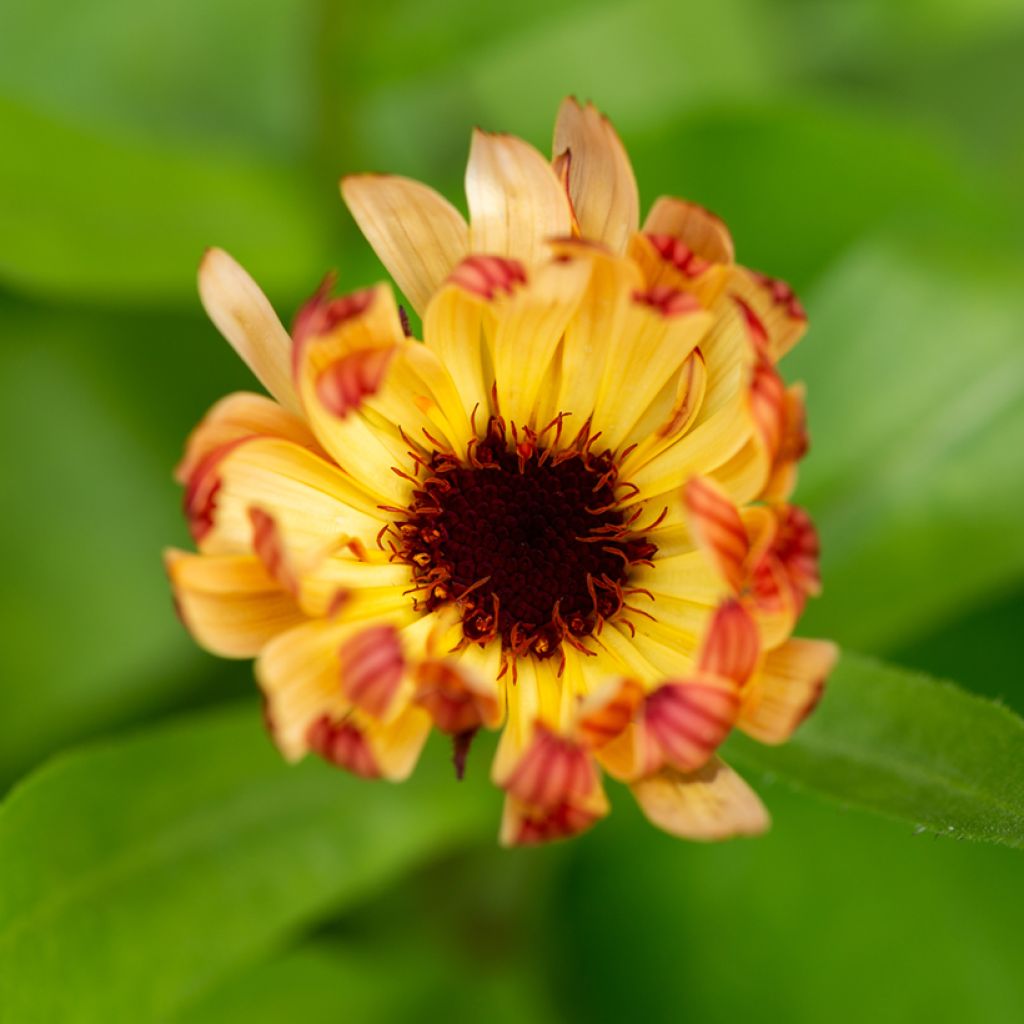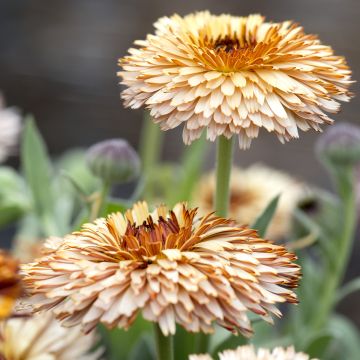

Calendula officinalis Sherbet Fizz Seeds - Pot Marigold
Calendula officinalis Sherbet Fizz Seeds - Pot Marigold
Calendula officinalis Sherbet Fizz
English Marigold
Lovely variety, but my seed packets arrived damp. We'll see after sowing!
Adeline, 03/04/2024
Special offer!
Receive a €20 voucher for any order over €90 (excluding delivery costs, credit notes, and plastic-free options)!
1- Add your favorite plants to your cart.
2- Once you have reached €90, confirm your order (you can even choose the delivery date!).
3- As soon as your order is shipped, you will receive an email containing your voucher code, valid for 3 months (90 days).
Your voucher is unique and can only be used once, for any order with a minimum value of €20, excluding delivery costs.
Can be combined with other current offers, non-divisible and non-refundable.
Home or relay delivery (depending on size and destination)
Schedule delivery date,
and select date in basket
This plant carries a 6 months recovery warranty
More information
We guarantee the quality of our plants for a full growing cycle, and will replace at our expense any plant that fails to recover under normal climatic and planting conditions.
Would this plant suit my garden?
Set up your Plantfit profile →
Description
Calendula officinalis, commonly known as Pot Marigold, is a popular, easy to grow annual. 'Sherbet Fizz' is an exquisite variety that displays a unique, harmonious combination of colours. The semi-double blooms have buff-coloured petals, with rosy tips and reddish undersides. Effortlessly romantic! Renowned for its medicinal qualities, Calendula is a valuable companion plant in the vegetable garden due to its insect repellent properties. Flowering starts about 10 weeks after sowing and continues for several weeks. Perfect for bringing colour to flower beds, borders and patios! Pot marigolds reseed easily and thrive in a sunny spot in loose, well-drained soil.
Like all members of the Asteraceae family, Calendula officinalis has characteristic daisy-shaped blooms called capitulums. It is a short-lived perennial plant, often treated as an annual. It occurs naturally in the Mediterranean region and naturalizes easily in warmer climates. 'Sherbet Fizz' forms a slightly flared clump of erect stems. At full maturity, it measures about 45 cm tall in full bloom for a spread of 30 cm. The velvety, lanceolate leaves release an intense aroma when crushed, often deemed rather unpleasant. Their solid green colour provides a perfect backdrop for the soft, buff and pink blooms. Depending on when they are sown, marigolds flower from spring until the first frosts, attracting countless pollinating insects. Each flower head is about 5 cm in diameter. It is made up of fertile, central disc flowers surrounded by a crown of long 'petals', which are actually called ray flowers. The flower heads open in the sun and close at night or on gloomy, overcast days. The seeds are contained in a curved, prickly seed head (achene). Marigolds reseed easily. Their germination is not hindered by the cold and the seedlings are content with all types of soil, as long as they get their fair share of sunshine!
With their bright, cheerful blooms, marigolds are invaluable for quickly decorating flower beds and sunny patios. They fit into naturalistic borders as well as more sophisticated flower beds, blending well with California poppies, red or blue salvias, love-in-a-mist and the grey foliage of wormwood and stachys. The bright yellow or orange flowers harmonise well with white, yellow and red ground covers roses. Calendula officinalis flowers are edible. They have a bright, peppery flavour and can be added to soups, salads and desserts. Calendula officinalis has been grown for centuries for its antiseptic, anti-inflammatory and healing properties. Its flowers can also be used to create natural yellow-orange dye.
Good to know: Calendulas repel root knot nematodes whilst attracting beneficial pollinating insects, making them an excellent companion plant in the vegetable garden.
Report an error about the product description
Flowering
Foliage
Plant habit
Botanical data
Calendula
officinalis
Sherbet Fizz
Asteraceae
English Marigold
Central Europe
Other Marigold seeds
View all →Planting and care
Marigolds can be direct sown as early as March in warmer climates. Elsewhere, it is best to wait until all risk of harsh frosts is over as the seeds prefer temperatures of around 20°C. Choose a sunny spot with well loosened soil. Scatter the seeds lightly, cover them with 1 or 2 mm of soil and water gently. The seeds will germinate in 5 to 10 days. If necessary, thin out the seedlings, leaving one plant every 30 cm. In warmer regions, it is also possible to start the seeds from September onwards by sowing them in pots and leaving them under cover until spring. They can then be transplanted in March in a container or in their final location.
Marigolds are fast-growing plants that thrive in a sheltered spot, in full sun (or partial shade in warmer climates). They are very low maintenance, providing they are grown in well-drained, light, moderately fertile soil. Protect the young plants from slugs and snails.
Sowing period
Intended location
-
, onOrder confirmed
Reply from on Promesse de fleurs
Similar products
Haven't found what you were looking for?
Hardiness is the lowest winter temperature a plant can endure without suffering serious damage or even dying. However, hardiness is affected by location (a sheltered area, such as a patio), protection (winter cover) and soil type (hardiness is improved by well-drained soil).

Photo Sharing Terms & Conditions
In order to encourage gardeners to interact and share their experiences, Promesse de fleurs offers various media enabling content to be uploaded onto its Site - in particular via the ‘Photo sharing’ module.
The User agrees to refrain from:
- Posting any content that is illegal, prejudicial, insulting, racist, inciteful to hatred, revisionist, contrary to public decency, that infringes on privacy or on the privacy rights of third parties, in particular the publicity rights of persons and goods, intellectual property rights, or the right to privacy.
- Submitting content on behalf of a third party;
- Impersonate the identity of a third party and/or publish any personal information about a third party;
In general, the User undertakes to refrain from any unethical behaviour.
All Content (in particular text, comments, files, images, photos, videos, creative works, etc.), which may be subject to property or intellectual property rights, image or other private rights, shall remain the property of the User, subject to the limited rights granted by the terms of the licence granted by Promesse de fleurs as stated below. Users are at liberty to publish or not to publish such Content on the Site, notably via the ‘Photo Sharing’ facility, and accept that this Content shall be made public and freely accessible, notably on the Internet.
Users further acknowledge, undertake to have ,and guarantee that they hold all necessary rights and permissions to publish such material on the Site, in particular with regard to the legislation in force pertaining to any privacy, property, intellectual property, image, or contractual rights, or rights of any other nature. By publishing such Content on the Site, Users acknowledge accepting full liability as publishers of the Content within the meaning of the law, and grant Promesse de fleurs, free of charge, an inclusive, worldwide licence for the said Content for the entire duration of its publication, including all reproduction, representation, up/downloading, displaying, performing, transmission, and storage rights.
Users also grant permission for their name to be linked to the Content and accept that this link may not always be made available.
By engaging in posting material, Users consent to their Content becoming automatically accessible on the Internet, in particular on other sites and/or blogs and/or web pages of the Promesse de fleurs site, including in particular social pages and the Promesse de fleurs catalogue.
Users may secure the removal of entrusted content free of charge by issuing a simple request via our contact form.
The flowering period indicated on our website applies to countries and regions located in USDA zone 8 (France, the United Kingdom, Ireland, the Netherlands, etc.)
It will vary according to where you live:
- In zones 9 to 10 (Italy, Spain, Greece, etc.), flowering will occur about 2 to 4 weeks earlier.
- In zones 6 to 7 (Germany, Poland, Slovenia, and lower mountainous regions), flowering will be delayed by 2 to 3 weeks.
- In zone 5 (Central Europe, Scandinavia), blooming will be delayed by 3 to 5 weeks.
In temperate climates, pruning of spring-flowering shrubs (forsythia, spireas, etc.) should be done just after flowering.
Pruning of summer-flowering shrubs (Indian Lilac, Perovskia, etc.) can be done in winter or spring.
In cold regions as well as with frost-sensitive plants, avoid pruning too early when severe frosts may still occur.
The planting period indicated on our website applies to countries and regions located in USDA zone 8 (France, United Kingdom, Ireland, Netherlands).
It will vary according to where you live:
- In Mediterranean zones (Marseille, Madrid, Milan, etc.), autumn and winter are the best planting periods.
- In continental zones (Strasbourg, Munich, Vienna, etc.), delay planting by 2 to 3 weeks in spring and bring it forward by 2 to 4 weeks in autumn.
- In mountainous regions (the Alps, Pyrenees, Carpathians, etc.), it is best to plant in late spring (May-June) or late summer (August-September).
The harvesting period indicated on our website applies to countries and regions in USDA zone 8 (France, England, Ireland, the Netherlands).
In colder areas (Scandinavia, Poland, Austria...) fruit and vegetable harvests are likely to be delayed by 3-4 weeks.
In warmer areas (Italy, Spain, Greece, etc.), harvesting will probably take place earlier, depending on weather conditions.
The sowing periods indicated on our website apply to countries and regions within USDA Zone 8 (France, UK, Ireland, Netherlands).
In colder areas (Scandinavia, Poland, Austria...), delay any outdoor sowing by 3-4 weeks, or sow under glass.
In warmer climes (Italy, Spain, Greece, etc.), bring outdoor sowing forward by a few weeks.



















































